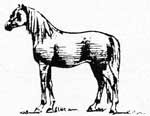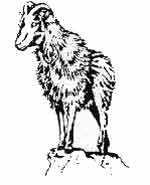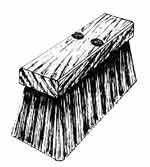|
|
 |
|
|
|
BRISTLE-The hairs of the pig, hog, or boar, generally taken from the neck, back and shoulder area of the animal. Bristle has a natural taper and flagged end (split end) which gives it qualities not found in other brush making fill materials. Bristle is superior for oil paint brushes and varnish brushes. Certain colors and types of bristle also make better quality artists brushes. Our knowledge and skill in choosing the proper bristles for the particular brushes come from generations of experience. All of our bristle is sterilized. |
|

|
|
HORSEHAIR-The hair from the tail or mane of the horse. Horsehair comes in various colors. The most commonly used are black and grey (mixed). Horsehair does not have a flagged end. Yet, horsehair is a resilient, long lasting brush fill material and is sought after for brushes, used in sweeping, polishing, cleaning, painting, and as a specialty applicator. All of our horsehair is sterilized. |
|

|
|
GOAT HAIR- Generally hair coming from the back of the animal. The goat hair we use is generally very soft and fine. Goat hair is generally white or grey (mixed) and can be dyed different colors. Goat hair brushes are used as applicator type brushes. All of our goat hair is sterilized. |
|

|
|
CAMEL HAIR- Sorry, this is not the hair of camels! Actually, camel refers to a group of soft hairs used for various artist style brushes. Quite often it is squirrel hair. As with all the other hairs we use, our camel hair is sterilized. |
|

|
|
OTHER SOFT HAIRS used for brushes include: Badger hair for shaving brushes; Ox hair, from the ears of Oxen used for sign writer brushes and chiseled cutters; Fitch hair, from the Russian Fitch or the North American Skunk, used for lacquering and varnishing brushes; and the Red Sable from the tail of the Kolinsky for artist brushes of the highest quality. |
|
|
|
|
|
HARDWOOD- We use only kiln dried hardwood blocks from seasoned wood. Hardwood blocks securely hold the brush materials in place. The hardwood blocks we use also help prevent cracking and splitting so common to softer varieties. |
|

|
|
PLASTIC BLOCKS- We use strong polystyrene, butyrate, polypropylene, and nylon blocks. These blocks can meet the strictest guidelines from the food industry to the medical profession. Used throughout industry as well, because they are bacteria proof, odor free, and liquid repellent. These blocks resist warping, slivering, and splintering. |
|
|
|
|



